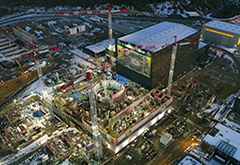ITER
ITER (International Thermonuclear Experimental Reactor) is an international nuclear fusion research and engineering megaproject, which will be the world's largest magnetic confinement plasma physics experiment. It is an experimental tokamak nuclear fusion reactor that is being built next to the Cadarache facility in Saint-Paul-lès-Durance, in Provence, southern France.
The ITER thermonuclear fusion reactor has been designed to produce a fusion plasma equivalent to 500 megawatts of thermal output power for around twenty minutes while 50 megawatts of thermal power are injected into the tokamak, resulting in a ten-fold gain of plasma heating power. Thereby the machine aims to demonstrate the principle of producing more thermal power from the fusion process than is used to heat the plasma, something that has not yet been achieved in any fusion reactor.
 The total electricity consumed by the reactor and facilities will range from 110MW up to 620 MW peak for 30-second periods during plasma operation. The reactor is only designed to produce a fusion plasma, and the emitted heat from the fusion reaction will be vented to the atmosphere without generating electricity. ITER's planned successor, DEMO, is expected to be the first fusion reactor to produce electricity in an experimental environment. DEMO's anticipated success is expected to lead to full-scale electricity-producing fusion power stations and future commercial reactors.
The total electricity consumed by the reactor and facilities will range from 110MW up to 620 MW peak for 30-second periods during plasma operation. The reactor is only designed to produce a fusion plasma, and the emitted heat from the fusion reaction will be vented to the atmosphere without generating electricity. ITER's planned successor, DEMO, is expected to be the first fusion reactor to produce electricity in an experimental environment. DEMO's anticipated success is expected to lead to full-scale electricity-producing fusion power stations and future commercial reactors.
The project is funded and run by seven member entities—the European Union, India, Japan, China, Russia, South Korea, and the United States. The EU, as host party for the ITER complex, is contributing about 45 percent of the cost, with the other six parties contributing approximately 9 percent each. In 2016 the ITER organization signed a technical cooperation agreement with the national nuclear fusion agency of Australia, enabling this country access to research results of ITER in exchange for construction of selected parts of ITER machine.
Construction of the ITER Tokamak complex started in 2013 and the building costs are now over US$14 billion as of June 2015. The facility is expected to finish its construction phase in 2025 and will start commissioning the reactor that same year. Initial plasma experiments are scheduled to begin in 2025, with full deuterium–tritium fusion experiments starting in 2035. If ITER becomes operational, it will become the largest magnetic confinement plasma physics experiment in use with a plasma volume of 840 cubic meters, surpassing the Joint European Torus by almost a factor of 10.
The first commercial demonstration fusion power station, named DEMO, is proposed to follow on from the ITER project. More details
 The total electricity consumed by the reactor and facilities will range from 110MW up to 620 MW peak for 30-second periods during plasma operation. The reactor is only designed to produce a fusion plasma, and the emitted heat from the fusion reaction will be vented to the atmosphere without generating electricity. ITER's planned successor, DEMO, is expected to be the first fusion reactor to produce electricity in an experimental environment. DEMO's anticipated success is expected to lead to full-scale electricity-producing fusion power stations and future commercial reactors.
The total electricity consumed by the reactor and facilities will range from 110MW up to 620 MW peak for 30-second periods during plasma operation. The reactor is only designed to produce a fusion plasma, and the emitted heat from the fusion reaction will be vented to the atmosphere without generating electricity. ITER's planned successor, DEMO, is expected to be the first fusion reactor to produce electricity in an experimental environment. DEMO's anticipated success is expected to lead to full-scale electricity-producing fusion power stations and future commercial reactors.The project is funded and run by seven member entities—the European Union, India, Japan, China, Russia, South Korea, and the United States. The EU, as host party for the ITER complex, is contributing about 45 percent of the cost, with the other six parties contributing approximately 9 percent each. In 2016 the ITER organization signed a technical cooperation agreement with the national nuclear fusion agency of Australia, enabling this country access to research results of ITER in exchange for construction of selected parts of ITER machine.
Construction of the ITER Tokamak complex started in 2013 and the building costs are now over US$14 billion as of June 2015. The facility is expected to finish its construction phase in 2025 and will start commissioning the reactor that same year. Initial plasma experiments are scheduled to begin in 2025, with full deuterium–tritium fusion experiments starting in 2035. If ITER becomes operational, it will become the largest magnetic confinement plasma physics experiment in use with a plasma volume of 840 cubic meters, surpassing the Joint European Torus by almost a factor of 10.
The first commercial demonstration fusion power station, named DEMO, is proposed to follow on from the ITER project. More details
